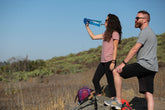Environmental sustainability is everyone’s responsibility. If we don’t all make better choices in our behavior, there is a chance of irreversibly damaging the planet. This isn’t just from the perspective of supporting green industries and making cities more eco-friendly. It’s also vital you take the time to consider how your individual and family activities can be adjusted for sustainability. One area of focus here is your vacation choices.
Heading to far-flung destinations is not good for the planet. Aside from the problem of fuel consumption, the emissions are significant. An average flight from New York to London produces 986kg of carbon dioxide per passenger. This is among the reasons why taking a camping trip can often be the most sustainable option. Not to mention that it’s an exciting, fun experience! Yet, there are certainly areas in which you can reduce your negative impact further while you’re out in the wild.
Making the Journey
Your trip to and from your destination can generate some of the most environmental harm. As such, you need to plan to make your route as ecologically friendly as possible. Firstly, consider the method of travel. Do you need to drive to get to your destination, or can you find more sustainable forms of transportation? Trains are generally greener, and even buses have a far lower emissions-per-passenger rate than cars.
You could consider a combination of methods, too. If a bus or train doesn’t take you to the camping location, is cycling the last several miles feasible? This brings us to another element of sustainability — packing light. This isn’t just practical if you’re cycling. It’s also important for reducing weight on any fuel-powered vehicles you’re using. The less you carry with you, the less fuel will be used to get you there. Reduce wherever you can. Do you need to take a 6 pack of spring water, or can you take a reusable water bottle and fill it up as you need it?
Your sustainability can extend to mapping the route, too. If you are driving to your destination, take time to work out which journey will generally see you using less fuel. Google has announced recently they’ll soon be adding options to its Maps service that offers the most fuel-efficient routes and will alert drivers to low emissions zones. If you’re driving a car with a manual transmission, driving in the highest gear possible within the speed limit can help minimize consumption, too. If you’re on a flat surface like a highway, cruise control can also be an effective sustainability tool here.
Prioritizing Efficiency
Efficiency is one of the cornerstones of sustainability. There is an increasing focus on tools and behavior to reduce waste and minimize resource consumption. The same approach should be applied to your activities during your camping trip.
Start with looking at the equipment you intend to use. Paraffin stoves and gas lighting have all been standard parts of the camping experience for decades. However, they tend to utilize a significant amount of non-renewable fuels and are generally not designed to be efficient. Consider making a few upgrades here. Our digital age has resulted in the development of some accessible camping tools that are also energy efficient. Light-emitting diode (LED) lamps are a longer-lasting approach than gas or traditional bulbs. Indeed, there are many pieces of equipment — radios, lighting systems, and battery chargers — designed to run on solar power alone. You can also obtain stoves that operate using natural debris rather than gas or firelighters, with examples on the market that also use the energy generated by the burn to provide electricity to charge your devices. Go through your kit and carefully consider what is genuinely serving you and the environment.
Efficiency doesn’t stop at your tool choices, though. Your behavior is a big contributor here. Rather than rely on external sources of heating and cooling, make more considerate choices about the clothing you bring and mats to sleep on to limit contact with bare ground. This can even extend to where you set up your tent — avoid exposed areas in colder months, and locate places of shade at the height of summer. It’s a mindset issue. You have to keep asking yourself what actions can you adjust to minimize having to utilize resources.
Reducing Your Impact
Going camping has a great impact on your life. This isn’t just from the perspective of an enjoyable vacation. Being out in nature offers the potential for positive therapeutic effects on your mental and physical wellbeing. Indeed, there is an increasing tendency for doctors to engage in prescription programs that give patients access to outdoor activities. Something as simple as regular gentle walking can help treat depression; even the sound of crickets chirping has positive effects on focus. However, just as nature has a positive impact on you, you also need to make sure your camping makes you a positive presence.
Each of your interactions with the natural world has the potential to leave a mark. Woods, waterways, and wildlife are all at the receiving end of your vacation behavior. This means to camp sustainably, you need to tread carefully. Be cognizant of the points of vulnerability in the area you’re visiting. Avoid creating noise or building fires in areas that are common habitats for wild animals. Remember, there is a global water crisis, so consider how you interact with natural sources — this includes avoiding introducing waste and chemical soaps into streams. In most cases, the adage of “leave nothing but footprints, take nothing but memories” is a good rule of thumb.
Conclusion
Camping is an opportunity to unwind and get closer to nature, but you also have a responsibility to act sustainably. Make certain you plan travel and activities with minimal resource consumption. Adopt energy-efficient practices wherever possible. Most importantly, while enjoying the great impact nature has on your wellbeing, ensure your presence has an equally positive effect.



